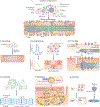Cardiomyocyte maturation: advances in knowledge and implications for regenerative medicine
- PMID: 32015528
- PMCID: PMC7239749
- DOI: 10.1038/s41569-019-0331-x
Cardiomyocyte maturation: advances in knowledge and implications for regenerative medicine
Abstract
Our knowledge of pluripotent stem cell (PSC) biology has advanced to the point where we now can generate most cells of the human body in the laboratory. PSC-derived cardiomyocytes can be generated routinely with high yield and purity for disease research and drug development, and these cells are now gradually entering the clinical research phase for the testing of heart regeneration therapies. However, a major hurdle for their applications is the immature state of these cardiomyocytes. In this Review, we describe the structural and functional properties of cardiomyocytes and present the current approaches to mature PSC-derived cardiomyocytes. To date, the greatest success in maturation of PSC-derived cardiomyocytes has been with transplantation into the heart in animal models and the engineering of 3D heart tissues with electromechanical conditioning. In conventional 2D cell culture, biophysical stimuli such as mechanical loading, electrical stimulation and nanotopology cues all induce substantial maturation, particularly of the contractile cytoskeleton. Metabolism has emerged as a potent means to control maturation with unexpected effects on electrical and mechanical function. Different interventions induce distinct facets of maturation, suggesting that activating multiple signalling networks might lead to increased maturation. Despite considerable progress, we are still far from being able to generate PSC-derived cardiomyocytes with adult-like phenotypes in vitro. Future progress will come from identifying the developmental drivers of maturation and leveraging them to create more mature cardiomyocytes for research and regenerative medicine.
Conflict of interest statement
Competing interests
C.E.M. is a scientific founder and equity holder in Sana Biotechnology. The other authors declare no competing interests.
Figures



References
-
- Sizarov A et al. Formation of the building plan of the human heart: morphogenesis, growth, and differentiation. Circulation 123, 1125–1135 (2011). - PubMed
-
- Hudlicka O & Brown MD Postnatal growth of the heart and its blood vessels. J. Vasc. Res 33, 266–287 (1996). - PubMed
-
- Hew KW & Keller KA Postnatal anatomical and functional development of the heart: a species comparison. Birth Defects Res. B Dev. Reprod. Toxicol 68, 309–320 (2003). - PubMed
Publication types
MeSH terms
Substances
Grants and funding
LinkOut - more resources
Full Text Sources
Other Literature Sources

